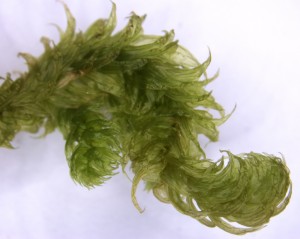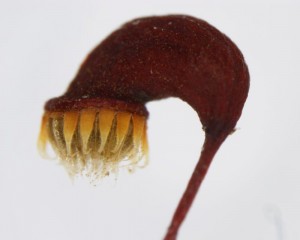Habitat
This species can usually be found growing on the hummus floors of subalpine coniferous forests. Although rare and sporadically dispersed at lower elevations, they can occur on logs. Their distribution is limited to the western regions of North America, ranging from southeastern Alaska to Oregon, and southwestern Alberta to western Montana. Large mats of this species can be seen in the subalpine zones of the North Shore Mountains.
Gametophyte
Overall structure:
 As the specific epithet implies, this a robust plant, with its large, irregularly branched yellow-green to brownish-green shoots which are often 10 cm or more in length. Plants usually form extensive mats over the substrata.
As the specific epithet implies, this a robust plant, with its large, irregularly branched yellow-green to brownish-green shoots which are often 10 cm or more in length. Plants usually form extensive mats over the substrata.
Leaves:
 The relatively large leaves (usually 1.5-2 mm long) are ovate to ovate-lanceolate with an acuminate apex.
The relatively large leaves (usually 1.5-2 mm long) are ovate to ovate-lanceolate with an acuminate apex.
 The leaves are distinctively plicate and have a double costa that ends near the middle of the leaf. They are falcate-secund whether wet or dry.
The leaves are distinctively plicate and have a double costa that ends near the middle of the leaf. They are falcate-secund whether wet or dry.
Leaf cells:
 The laminal cells are elongate, pitted and smooth.
The laminal cells are elongate, pitted and smooth.
Stem:
 This species generally has an abundance of green paraphyllia branching from the stem. Furthermore, the stem may appear thick due to the presence of closely set leaves.
This species generally has an abundance of green paraphyllia branching from the stem. Furthermore, the stem may appear thick due to the presence of closely set leaves.
Sporophyte
Overall structure:
The sporophytes of R. robusta grow from the side of the stem (pleurocarpous) and are rare. When it reaches maturity, usually in late autumn, the sporophyte is red-brown in color.
Sporangium:
 The sporangium is smooth, cylindrical and horizontal. The peristome teeth are double.
The sporangium is smooth, cylindrical and horizontal. The peristome teeth are double.
Seta:
The seta can reach heights of 2.5-3 cm and is usually brown in color.
Spores: The spores are smooth.


